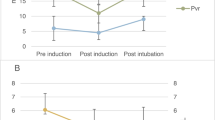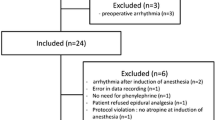Abstract
Pulse transit time (PTT) is the time that it takes for the arterial pulse pressure wave to travel from the aortic valve to the periphery. It is a simple noninvasive technique for evaluating vascular changes. This study investigated the vascular changes by propofol during the induction of anesthesia in pediatric patients with the measuring of PTT. Without premedication, 2 mg/kg of propofol was administered intravenously with monitoring of electrocardiogram (ECG) and photoplethysmograph (PPG) in 20 pediatric patients aged 3–7 years. The ECG and PPG data were obtained for 1 min before propofol injection (baseline PTT) and 2 min after administration of propofol in the operating room. The PTT was defined as the time interval from the R-wave on the ECG to the maximum upslope of the corresponding PPG. The PTT was calculated off-line after collecting the data. The mean baseline PTT was 166.2 ± 25.9 ms and maximum PTT after propofol injection was 315.9 ± 64.9 ms (the interval between injection and the peak was 17.3 ± 7.6 s). The PTT after the peak changed variously; most of the patients showed no plateau; the PTT decreased progressively after the peak. The PTT after propofol administration prolonged in short time and rapidly recovered toward to the baseline values in pediatric patients. In conclusion, the baseline PTT in children is shorter comparing with adults and the vasodilatory effect of propofol on the vessels as described by the PTT was rapid and the recovery was faster, although the response to propofol was more varied than in adults.



Similar content being viewed by others
References
Lan YC, Shen CH, Kang HM, Chong FC. Pulse transit time reveals drug kinetics on vascular changes affected by propofol. Comput Methods Biomech Biomed Eng. 2012;15(9):949–52.
Sharwood-Smith G, Bruce J, Drummond G. Assessment of pulse transit time to indicate cardiovascular changes during obstetric spinal anaesthesia. Br J Anaesth. 2006;96(1):100–5.
Kim SH, Song JG, Park JH, Kim JW, Park YS, Hwang GS. Beat-to-beat tracking of systolic blood pressure using noninvasive pulse transit time during anesthesia induction in hypertensive patients. Anesth Analg. 2013;116(1):94–100.
Kawasaki T, Sasayama S, Yagi S, Asakawa T, Hirai T. Non-invasive assessment of the age related changes in stiffness of major branches of the human arteries. Cardiovasc Res. 1987;21(9):678–87.
Senzaki H, Akagi M, Hishi T, Ishizawa A, Yanagisawa M, Masutani S, Kobayashi T, Awa S. Age-associated changes in arterial elastic properties in children. Eur J Pediatr. 2002;161(10):547–51.
Gardner AW, Parker DE. Association between arterial compliance and age in participants 9 to 77 years old. Angiology. 2010;61(1):37–41.
Kortekaas MC, Niehof SP, van Velzen MH, Galvin EM, Stolker RJ, Huygen FJ. Comparison of bilateral pulse arrival time before and after induced vasodilation by axillary block. Physiol Meas. 2012;33(12):1993–2002.
Claeys MA, Gepts E, Camu F. Haemodynamic changes during anaesthesia induced and maintained with propofol. Br J Anaesth. 1988;60(1):3–9.
Lepage JY, Pinaud ML, Helias JH, Cozian AY, Le Normand Y, Souron RJ. Left ventricular performance during propofol or methohexital anesthesia: isotopic and invasive cardiac monitoring. Anesth Analg. 1991;73(1):3–9.
Muzi M, Berens RA, Kampine JP, Ebert TJ. Venodilation contributes to propofol-mediated hypotension in humans. Anesth Analg. 1992;74(6):877–83.
Robinson BJ, Ebert TJ, O’Brien TJ, Colinco MD, Muzi M. Mechanisms whereby propofol mediates peripheral vasodilation in humans. Sympathoinhibition or direct vascular relaxation? Anesthesiology. 1997;86(1):64–72.
Stevanov M, Baruthio J, Eclancher B. Fabrication of elastomer arterial models with specified compliance. J Appl Physiol (1985). 2000;88(4):1291–4.
Schmalgemeier H, Bitter T, Bartsch S, Bullert K, Fischbach T, Eckert S, Horstkotte D, Oldenburg O. Pulse transit time: validation of blood pressure measurement under positive airway pressure ventilation. Sleep Breath. 2012;16(4):1105–12.
Geddes LA, Voelz MH, Babbs CF, Bourland JD, Tacker WA. Pulse transit time as an indicator of arterial blood pressure. Psychophysiology. 1981;18(1):71–4.
Rigouzzo A, Servin F, Constant I. Pharmacokinetic-pharmacodynamic modeling of propofol in children. Anesthesiology. 2010;113(2):343–52.
Acknowledgments
All the authors don’t have any financial relationship with the organization that sponsored the research.
Conflict of interest
The authors declare that they have no conflict of interest.
Author information
Authors and Affiliations
Corresponding author
Rights and permissions
About this article
Cite this article
Kang, JE., Song, IK., Lee, JH. et al. Pulse transit time shows vascular changes caused by propofol in children. J Clin Monit Comput 29, 533–537 (2015). https://doi.org/10.1007/s10877-015-9680-0
Received:
Accepted:
Published:
Issue Date:
DOI: https://doi.org/10.1007/s10877-015-9680-0




